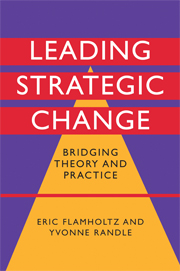Book contents
- Frontmatter
- Contents
- List of exhibits
- Preface
- Acknowledgments
- Part I An integrative framework for leading strategic and organizational change
- Part II Leading strategic change in actual organizations
- 4 Leading strategic and organizational change at Countrywide Financial Corporation
- 5 Leading change at Starbucks Coffee Company
- 6 Strategic marketing through HR interventions: a case study of Indian Oil Corporation
- 7 The evolution of Stan Tashman and Associates
- 8 Leading strategic and organizational change at IndyMac Bank
- 9 Leading strategic and organizational change at Infogix
- 10 Leading strategic and organizational change: the transformation of structure at Pardee Homes
- 11 Leading strategic and organizational change at Tata Steel: the role of culture
- 12 Leading strategic and organizational change at Westfield: transformation to a global enterprise
- Part III Leading strategic change: lessons learned from practice
- Appendix: References for further reading on leading change
- Index
7 - The evolution of Stan Tashman and Associates
from Part II - Leading strategic change in actual organizations
Published online by Cambridge University Press: 22 September 2009
- Frontmatter
- Contents
- List of exhibits
- Preface
- Acknowledgments
- Part I An integrative framework for leading strategic and organizational change
- Part II Leading strategic change in actual organizations
- 4 Leading strategic and organizational change at Countrywide Financial Corporation
- 5 Leading change at Starbucks Coffee Company
- 6 Strategic marketing through HR interventions: a case study of Indian Oil Corporation
- 7 The evolution of Stan Tashman and Associates
- 8 Leading strategic and organizational change at IndyMac Bank
- 9 Leading strategic and organizational change at Infogix
- 10 Leading strategic and organizational change: the transformation of structure at Pardee Homes
- 11 Leading strategic and organizational change at Tata Steel: the role of culture
- 12 Leading strategic and organizational change at Westfield: transformation to a global enterprise
- Part III Leading strategic change: lessons learned from practice
- Appendix: References for further reading on leading change
- Index
Summary
This chapter describes the transformation of Stan Tashman and Associates (a privately owned family-run business) from an entrepreneurial manufacturers' representative agency in the hardware and home improvement industry to an innovative, “best in class,” professionally managed sales and service business as a response to changing environmental (industry) conditions. The chapter also describes how, after completing the initial transformation of the company, the management team successfully guided the company through a period of rapid growth in response to changing industry dynamics. Specifically, the company quadrupled in size between 2004 and 2006 (increasing from 130 to 570 employees) while maintaining satisfied customers and retaining key cultural values (including a commitment to operating with integrity, valuing people, and providing excellent service).
The case gives us insight into the process of leading strategic and organizational change in response to changes in the environment. Specifically, the organizational changes were driven by current and expected industry consolidation. First we describe the history and development of Stan Tashman and Associates, and then we examine the process of change undertaken by the company.
Company background
The company was founded in southern California in 1961 when Stan Tashman agreed to represent his first manufacturer, Oxwall Tool Company. As a manufacturer's representative, or agent, it was Tashman's job to persuade retail businesses – such as hardware, drug, auto, discount, and variety stores and chains – to stock the manufacturer's products.
- Type
- Chapter
- Information
- Leading Strategic ChangeBridging Theory and Practice, pp. 123 - 135Publisher: Cambridge University PressPrint publication year: 2008



